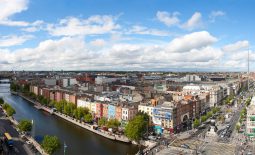Irish Famine Myth (The Great Hunger–An Gorta Mor)
Yes, the Irish famine did occur, but it didn’t need to. On this coming St. Patrick’s day when everyone celebrates the glory of the Irish, I felt it necessary to help spread the real story of the Irish famine of the mid-1800’s. In 1847 alone, 400,000 Irish died and a total of almost 1,500,000 died due to starvation (not to mention the 2,000,000 or so that emigrated to North America), but it wasn’t due to a shortage of food. Yes, there was a potato blight that damaged much of the crop but there was plenty of food produced in Ireland to support the population. The famine was brought about by the British and their supporters who from 1845-1847 took 26 million bushels of corn, 257k sheep, 481k pigs, 186k Ox, 10k cattle, 4k horses, 1 million gallons of butter, 1.7m gallons of grain alcohol, and 4k ships of peas, beans, rabbits, salmon, honey and potatoes from Ireland to British ports. The forced starvation of the Irish was a culmination of several hundred years of effort by the British to wipeout the Irish, starting with Oliver Cromwell–the Hitler of Britain. Cromwell started this well-documented genocide effort in the mid-1600’s. The Irish are not fully innocent in this debacle as some middle-class and wealthy Irish made loads of money exporting the goods to British even while their kinsman were dying. The Irish famine was avoidable but this type of genocide and class warfare still occurs in our “civilized” society today. Why else would the richest nation in the world have millions of homeless people starving on the streets? Instead of raising our beer glasses this St. Patrick’s Day we should lower our heads in shame for humankind’s history of treating so many living creatures, now and in the past, so poorly due to our greed.






June 5, 2009 @ 3:51 pm
Kyle,
Your comment was right on the money. A great book is Scally’s
The End of Hidden Ireland which explains some of the reasons why the famine was “hidden.” One of them was the continued presence of British soldiers in the North.
I have a website and blog at http://www.famineghost.com
Thanks.
Jack O’Keefe
June 10, 2009 @ 3:20 pm
Just discovered an article by james C. Mullin at irelandsown.com/afroirish.html on the slavery Cromwell put the Irish through: “Under Cromwell’s policy . . . those found east of the Shannon faced the death penalty or slavery in the West Indies.”
The Governor of Galway took people out of their beds to sell them as slaves in the West “Indies.” This was all done under the auspices of the Church of England “to convert the heathens.” Cromwell’s son captured 1,000 Irish wenches to sell to Barbados where they would intermarry with slaves to breed more children
June 10, 2009 @ 4:47 pm
Just discovered an article by james C. Mullin at irelandsown.com/afroirish.html on the slavery Cromwell put the Irish through: “Under Cromwell’s policy . . . those found east of the Shannon faced the death penalty or slavery in the West Indies.”
The Governor of Galway took people out of their beds to sell them as slaves in the West “Indies.” This was all done under the auspices of the Church of England “to convert the heathens.” Cromwell’s son captured 1,000 Irish wenches to sell to Barbados where they would intermarry with slaves to breed more children
June 12, 2009 @ 10:28 am
More on the article above:
famineghostgenocideoftheIrish
Besides the Irish driven off their land and sent to die on coffin ships, Cromwell and his son murdered and enslaved the Irish. Those Irish found east of the Shannon were either killed or sent to plantations in Barbados, Trinidad or St. Kitts. Cromwell’s son sold a thousand Irish wenches to Barbados for the purpose of mating with slaves to produce more slaves.
England was king of the slave trade, having defeated the Dutch and Spanish. Tables from the Royal African Company cite that between 1690 and 1807 the company took 2,597, 400 slaves out of Africa, all under the religious theme of “converting the heathers.”
This was the same policy exercised in famine Ireland–to rid the Irish of popery.
more sins are committed under the name of religion that his world dreams of.
June 12, 2009 @ 10:29 am
More on the article above:
famineghostgenocideoftheIrish
Besides the Irish driven off their land and sent to die on coffin ships, Cromwell and his son murdered and enslaved the Irish. Those Irish found east of the Shannon were either killed or sent to plantations in Barbados, Trinidad or St. Kitts. Cromwell’s son sold a thousand Irish wenches to Barbados for the purpose of mating with slaves to produce more slaves.
England was king of the slave trade, having defeated the Dutch and Spanish. Tables from the Royal African Company cite that between 1690 and 1807 the company took 2,597, 400 slaves out of Africa, all under the religious theme of “converting the heathers.”
This was the same policy exercised in famine Ireland–to rid the Irish of popery.
more sins are committed under the name of religion than this world dreams of.
July 26, 2009 @ 12:04 am
Thanks for explaining about Cromwell. I was googling after hearing the Irish accent in Trinidad.
I read a book by a couple of economics professors, David Levy and Sandra Peart, Vanity of the Philosophers. One major theme there is a history of the English darwinist construction of the Irish as all the stereotypes US southerners applied to blacks during slavery and Jim Crow. You can find reproductions of editorial cartoons and sold-out scientists’ quotes which display the stereotypes that seem self-rebutting now since one white man is talking about another. I also now realize the added dimension of meaning to the portrayal of Irish with negroid features, and the mixing of economic implications since that propaganda served English slavers.
Appalling, and then we see once again the religious hypocrisy that often crops up as trojan horse of genocide and looting. We are not living in a post-racial or post-racist era if we do not know more of the history.
The most fundamental theme of Levy and Peart is that “sympathy” was removed from economic thought in the 19th century, under guise of darwinism and platonic utopian pragmatism. Certain businesses including slavery rely on projection of the lie that greed is the root of all good, and that that is a Christian notion instead of the opposite of such. Think, now, haven’t we been thought that sympathy is an evil and dangerous notion with respect to economics? If trust is currency, why not sympathy? Trust without reciprocal sympathy is like right without responsibility.
July 26, 2009 @ 1:15 am
Also in the book Vanity of the Philosopher, the English propagandists are documented as condemning feeding the Irish a potato or a job as that would be “race treason”, ironically as whites posing other whites as being a different race which strikes us now as self-rebutting. That pseudo-darwinist concept of Sympathy as Sin then melds economic and anthropological pseudo-science into a genocidal leviathan.
In the bible, Ezekiel 12 and 24, God looks at a nation’s capital and its imperial elite, and sees a pot full of blood and cannibalism and a mercenary enterprise. Naturally they saw themselves as moral and wise, and Levy and Peart find the English puffing in all pompous hypocritical foolery as I imagine also do the books you mentioned. “Out of Africa, Out of Ireland” and “British Racism: Before, During and After the Famine”. Levy and Peart call the dot-in-a-pot hypocrisy and pseudo-science “hierarchicalism”.
March 20, 2010 @ 11:36 am
Bob Dodds is correct in his assessment of England’s policy of laizzes- faire economics in treating Irish poverty. prime Minister Trevelyan viewed the great hunger as a manifestaion of God’s Providence in dealing with a wicked people (Catholics). Mary Pat Kelly’s Galway Bay tells some of the history.
May 7, 2010 @ 9:50 am
I’m just finishing the editing of Famine Ghost (See http://www.famineghost.com ). Any suggestions for publication?
John Waters has some excellent points on the effects of the famine on today’ Ireland: John Waters describes the effect of the Famine on today’s Ireland: “The Famine left an endless array of legacies which live with us to the present moment: the hemorrhaging of our youth, the corruption of our spirituality, the destruction of our independence of spirit, the final assault on our sense of the self. But it would be an even greater tragedy if that calamitous event, which carries such a shocking emblematic truth about our history, were to be used to lock us out forever from the truth of that history.”